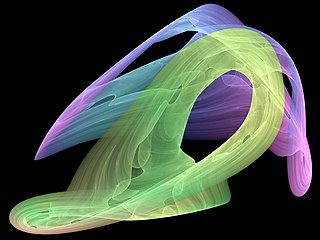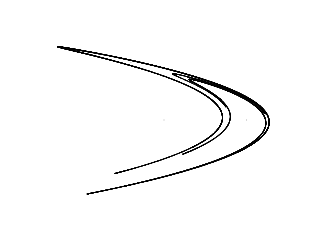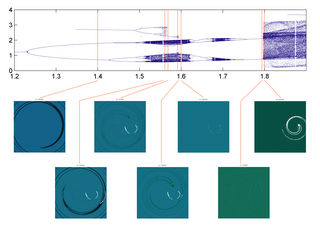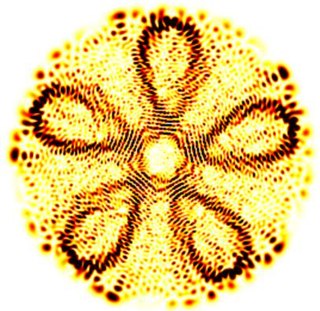Related Research Articles

In the mathematical field of dynamical systems, an attractor is a set of states toward which a system tends to evolve, for a wide variety of starting conditions of the system. System values that get close enough to the attractor values remain close even if slightly disturbed.

The edge of chaos is a transition space between order and disorder that is hypothesized to exist within a wide variety of systems. This transition zone is a region of bounded instability that engenders a constant dynamic interplay between order and disorder.

In mathematics, the Hénon map, sometimes called Hénon–Pomeau attractor/map, is a discrete-time dynamical system. It is one of the most studied examples of dynamical systems that exhibit chaotic behavior. The Hénon map takes a point (xn, yn) in the plane and maps it to a new point
In dynamical systems theory, a period-doubling bifurcation occurs when a slight change in a system's parameters causes a new periodic trajectory to emerge from an existing periodic trajectory—the new one having double the period of the original. With the doubled period, it takes twice as long for the numerical values visited by the system to repeat themselves.

The Lorenz system is a system of ordinary differential equations first studied by mathematician and meteorologist Edward Lorenz. It is notable for having chaotic solutions for certain parameter values and initial conditions. In particular, the Lorenz attractor is a set of chaotic solutions of the Lorenz system. In popular media the "butterfly effect" stems from the real-world implications of the Lorenz attractor, namely that several different initial chaotic conditions evolve in phase space in a way that never repeats, so all chaos is unpredictable. This underscores that chaotic systems can be completely deterministic and yet still be inherently unpredictable over long periods of time. Because chaos continually increases in systems, we cannot predict the future of systems well. E.g., even the small flap of a butterfly’s wings could set the world on a vastly different trajectory, such as by causing a hurricane. The shape of the Lorenz attractor itself, when plotted in phase space, may also be seen to resemble a butterfly.
Harry L. Swinney is an American physicist noted for his contributions to the field of nonlinear dynamics.

Ofer Biham is a faculty member at The Racah Institute of Physics of the Hebrew University of Jerusalem in Israel. Biham received his Ph.D. for research on quasiperiodic systems at the Weizmann Institute of Science in 1988, under the supervision of David Mukamel.
Dissipative solitons (DSs) are stable solitary localized structures that arise in nonlinear spatially extended dissipative systems due to mechanisms of self-organization. They can be considered as an extension of the classical soliton concept in conservative systems. An alternative terminology includes autosolitons, spots and pulses.
In theoretical computer science, chaos computing is the idea of using chaotic systems for computation. In particular, chaotic systems can be made to produce all types of logic gates and further allow them to be morphed into each other.
A coupled map lattice (CML) is a dynamical system that models the behavior of non-linear systems. They are predominantly used to qualitatively study the chaotic dynamics of spatially extended systems. This includes the dynamics of spatiotemporal chaos where the number of effective degrees of freedom diverges as the size of the system increases.
Cybernetical physics is a scientific area on the border of cybernetics and physics which studies physical systems with cybernetical methods. Cybernetical methods are understood as methods developed within control theory, information theory, systems theory and related areas: control design, estimation, identification, optimization, pattern recognition, signal processing, image processing, etc. Physical systems are also understood in a broad sense; they may be either lifeless, living nature or of artificial (engineering) origin, and must have reasonably understood dynamics and models suitable for posing cybernetical problems. Research objectives in cybernetical physics are frequently formulated as analyses of a class of possible system state changes under external (controlling) actions of a certain class. An auxiliary goal is designing the controlling actions required to achieve a prespecified property change. Among typical control action classes are functions which are constant in time, functions which depend only on time, and functions whose value depends on measurement made at the same time or on previous instances. The last class is of special interest since these functions correspond to system analysis by means of external feedback.
Peter Grassberger is a retired professor who worked in statistical and particle physics. He made contributions to chaos theory, where he introduced the idea of correlation dimension, a means of measuring a type of fractal dimension of the strange attractor.

Miguel Angel Fernández Sanjuán is a Spanish Theoretical Physicist from Leon, Spain. He is known for his contributions in nonlinear dynamics, chaos theory, and control of chaos, and has published several scientific papers and popular news articles. He has supervised around 20 PhD students in Nonlinear Dynamics, Chaos and Complex Systems.

Oreste Piro is a dynamical systems theorist and biophysicist. He is at the Universitat de les Illes Balears (UIB) in Palma de Mallorca.

In applied mathematics and astrodynamics, in the theory of dynamical systems, a crisis is the sudden appearance or disappearance of a strange attractor as the parameters of a dynamical system are varied. This global bifurcation occurs when a chaotic attractor comes into contact with an unstable periodic orbit or its stable manifold. As the orbit approaches the unstable orbit it will diverge away from the previous attractor, leading to a qualitatively different behaviour. Crises can produce intermittent behaviour.

Quantum scarring refers to a phenomenon where the eigenstates of a classically chaotic quantum system have enhanced probability density around the paths of unstable classical periodic orbits. The instability of the periodic orbit is a decisive point that differentiates quantum scars from the more trivial observation that the probability density is enhanced in the neighborhood of stable periodic orbits. The latter can be understood as a purely classical phenomenon, a manifestation of the Bohr correspondence principle, whereas in the former, quantum interference is essential. As such, scarring is both a visual example of quantum-classical correspondence, and simultaneously an example of a (local) quantum suppression of chaos.

Jürgen Kurths is a German physicist and mathematician. He is senior advisor in the research department Complexity Sciences of the Potsdam Institute for Climate Impact Research, a Professor of Nonlinear Dynamics at the Institute of Physics at the Humboldt University, Berlin, and a 6th-century chair for Complex Systems Biology at the Institute for Complex Systems and Mathematical Biology at Kings College, Aberdeen University (UK). His research is mainly concerned with nonlinear physics and complex systems sciences and their applications to challenging problems in Earth system, physiology, systems biology and engineering.
Celso Grebogi is a Brazilian theoretical physicist who works in the area of chaos theory. He is one among the pioneers in the nonlinear and complex systems and chaos theory. Currently he works at the University of Aberdeen as the "Sixth Century Chair in Nonlinear and Complex Systems". He has done extensive research in the field of plasma physics before his work on the theory of dynamical systems. He and his colleagues have shown with a numerical example that one can convert a chaotic attractor to any one of numerous possible attracting time-periodic motions by making only small time-dependent perturbations of an available system parameter. This article is considered as one among the classic works in the control theory of chaos and their control method is known as the OGY method. He was listed in the 2016 Thomson Reuters Citation Laureates.

Edward Ott is an American physicist most noted for his contributions to the development of chaos theory.
Robert Everett Ecke is an American experimental physicist who is a laboratory fellow and director emeritus of the Center for Nonlinear Studies (CNLS) at Los Alamos National Laboratory and Affiliate Professor of Physics at the University of Washington. His research has included chaotic nonlinear dynamics, pattern formation, rotating Rayleigh-Bénard convection, two-dimensional turbulence, granular materials, and stratified flows. He is a Fellow of the American Physical Society (APS) and of the American Association for the Advancement of Science (AAAS), was chair of the APS Topical Group on Statistical and Nonlinear Physics, served in numerous roles in the APS Division of Fluid Dynamics, and was the Secretary of the Physics Section of the AAAS.
References
- 1 2 Lluís Alsedà (March 8, 2007). "On the definition of Strange Nonchaotic Attractor" (PDF). Retrieved 2014-05-07.
- ↑ Grebogi, Celso; Ott, Edward; Pelikan, Steven; Yorke, James A. (1984). "Strange attractors that are not chaotic". Physica D: Nonlinear Phenomena. Elsevier BV. 13 (1–2): 261–268. doi:10.1016/0167-2789(84)90282-3. ISSN 0167-2789.
- ↑ Gopal, R.; Venkatesan, A.; Lakshmanan, M. (2013). "Applicability of 0-1 Test for Strange Nonchaotic Attractors". Chaos: An Interdisciplinary Journal of Nonlinear Science. 23 (2): 023123. arXiv: 1303.0169 . Bibcode:2013Chaos..23b3123G. doi:10.1063/1.4808254. PMID 23822488.
- ↑ Ditto, W. L.; Spano, M. L.; Savage, H. T.; Rauseo, S. N.; Heagy, J.; Ott, E. (1990-07-30). "Experimental observation of a strange nonchaotic attractor". Physical Review Letters. American Physical Society (APS). 65 (5): 533–536. doi:10.1103/physrevlett.65.533. ISSN 0031-9007.
- ↑ Lindner, John F.; Kohar, Vivek; Kia, Behnam; Hippke, Michael; Learned, John G.; Ditto, William L. (2015-02-03). "Strange Nonchaotic Stars". Physical Review Letters. American Physical Society (APS). 114 (5): 054101. arXiv: 1501.01747 . doi: 10.1103/physrevlett.114.054101 . ISSN 0031-9007.
- ↑ "Applied Chaos Laboratory". appliedchaoslab.phys.hawaii.edu.
- ↑ Clara Moskowitz (2015-02-09). "Strange Stars Pulsate According to the Golden Ratio". Scientific American. Retrieved 2020-01-11.
- ↑ Lindner, John F.; Kohar, Vivek; Kia, Behnam; Hippke, Michael; Learned, John G.; Ditto, William L. (2015). "Stars That Act Irrational". Physical Review Letters. 114 (5): 054101. arXiv: 1501.01747 . Bibcode:2015PhRvL.114e4101L. doi:10.1103/PhysRevLett.114.054101. PMID 25699444.